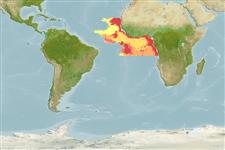klasifikasi / Names
Nama-nama umum | Sinonim (persamaan) | Catalog of Fishes(Marga, Jenis) | ITIS | CoL | WoRMS | Cloffa
>
Scombriformes (Mackerels) >
Caristiidae (Manefishes)
Etymology: Paracaristius: Name from the Greek 'para' meaning around or near and Caristius.; nemorosus: Name from Latin adjective nemorosus, meaning 'forested' or 'wooded', referring to the various series of mutifid papillae in the mouth and branchial chamber (Ref. 87954).
Environment: milieu / climate zone / depth range / distribution range
Ekologi
laut; kisaran kedalaman 750 - 1550 m (Ref. 87954). Tropical; 20°N - 10°S (Ref. 87954)
Atlantic Ocean.
Size / Weight / umur
Maturity: Lm ? range ? - ? cm
Max length : 17.0 cm SL jantan/; (Ref. 87954); 20.0 cm SL (female)
deskripsi pendek
Morfologi | Morfometrik
duri punggung lunak (Keseluruhan (total)): 30-33; Sirip dubur lunak: 15 - 18; vertebrata, bertulang belakang: 34 - 37. This species is distinguished from P. maderensis and P. nudarcus by having fingerlike papillae along the dorsal margin of the hyoid arch and at the interhyal-posterior ceratohyal articulation, with dorsal-fin rays 30-33 (vs. 27-31), fewer anal-fin rays 15-18 (vs. 17-20); differs from P. aquilus by having greater body depth, >50% SL (vs <50% SL in P. aquilus) and its short and deep caudal-peduncle (vs. relatively long and shallow in P. aquilus) (Ref. 87954).
Life cycle and mating behavior
Kematangan | Reproduksi, perkembang biakan | Pemijahan | telur-telur | Fecundity | Larva
Stevenson, D.E. and C.P. Kenaley, 2011. Revision of the manefish genus Paracaristius (Teleostei: Percomorpha: Caristiidae), with descriptions of a new genus and three new species. Copeia 2011(3):385-399 (Ref. 87954)
Status IUCN Red List (Ref. 130435)
ancaman kepada manusia
Harmless
penggunaan manusia
informasi lanjut
Nama-nama umumSinonim (persamaan)metabolismePemangsaEkotoksikologiReproduksi, perkembang biakanKematanganPemijahanSpawning aggregationFecunditytelur-telurpekembangan telor
Umur / SaizPertumbuhanpanjang-beratpanjang-panjangukuran frekuensiMorfometrikMorfologiLarvaDinamika larvapemulihanKelimpahanBRUVS
AcuanBudidaya airprofil budidaya airStrainGenetikaElectrophoresesDiturunkanPenyakit-penyakitPengolahanNutrientsMass conversion
mitraGambarStamps, Coins Misc.Suara-suaraCiguateraKecepatanTipe renangArea insangOtolithsOtakPenglihatan / visi
Alat, peralatan
laporan khas
muat turun XML
Sumber internet
Estimates based on models
Preferred temperature (Ref.
123201): 4.4 - 5.7, mean 4.5 °C (based on 9 cells).
Phylogenetic diversity index (Ref.
82804): PD
50 = 0.5625 [Uniqueness, from 0.5 = low to 2.0 = high].
Bayesian length-weight: a=0.01995 (0.00906 - 0.04395), b=3.01 (2.83 - 3.19), in cm total length, based on all LWR estimates for this body shape (Ref.
93245).
Trophic level (Ref.
69278): 3.6 ±0.5 se; based on size and trophs of closest relatives
Fishing Vulnerability (Ref.
59153): Low vulnerability (14 of 100).
